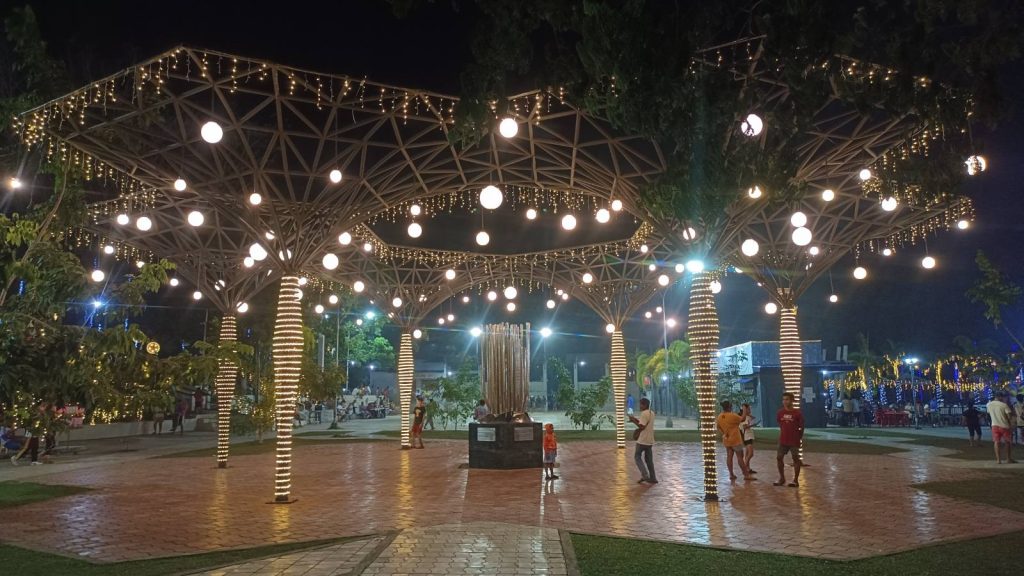
Present-day Escalante City Public Plaza, the site of the infamous Escalante massacre by Fame&Fortune2023
Escape to Escalante City, Negros Occidental
Tucked away on the northeastern tip of Negros Occidental, facing the Cebu Strait, lies the component city of Escalante—known as the “Blessed Land.” Far from a sleepy town, Escalante pulses with a rich tapestry of history, vibrant culture, and stunning natural landscapes. This coastal city has 21 barangays, a 2020 population of 96,159 people, and a land area of 192.75 sq. kilometers (74.43 sq. miles).
Geography & Biodiversity
Escalante’s terrain includes rolling volcanic hills like Mt. Lunay—with its sulfuric spring at the base—and lush coastal ecosystems featuring mangroves, seagrass beds, and patches of coral reef. The city is bordered by Sagay to the northwest, Toboso to the south, and Cebu Strait to the east.
1. A Coastal City with Ancient Roots
Archaeological excavations in barangay Japitan revealed burial sites dating back to the 12th century—a testament to its early trade ties with Chinese and Japanese merchants.
Originally called Manlambus (“to strike with a club”), legend says its fish-abundant waters once allowed villagers to catch fish with clubs alone. In 1860, it was renamed Escalante, after a Spanish town, by Fr. Cipriano Navarro during Spanish rule.
by JJ Lee PCmotoVlog
2. City Evolution: Municipality to City
- Became a municipality in November 1856, with Nueva Sevilla as its first seat.
- The administrative center moved from Old Población to Barangay Balintawak in 1958.
- In 2001, Escalante officially gained city status (RA 9014) following a plebiscite.
3. Cultural Highlights & Events
Manlambus Festival – Held every May 30, this vibrant celebration reenacts the traditional fish-catching dance using “lambus,” honoring the city’s name and heritage.
Additionally, the city marks its Charter Anniversary on February 28, featuring sports events, parades, job fairs, and more.
4. Landmarks & Tourist Attractions
- St. Francis of Assisi Church Ruins (Old Poblacion): Late 19th-century Augustinian Recollect relic, now recognized as a historic structure.
- City Museum & Plaza Complex: The 1930s municipal building now serves as a museum hosting archaeological and ethnographic collections, flanked by the Rizal Monument, bandstand, skating rink, and portal—remnants of American and early Republic eras.
- Escalante Massacre Monument: Commemorates the “Escalante Massacre” of September 20, 1985, where paramilitary forces killed 20 protestors—a dark chapter linked to the Marcos era.
5. Beach Escapes & Nature Trips
- Bonista Beach Resort (Brgy. Buenavista): A laid-back white-sand getaway about 15 km from city, equipped with cottages, pool, restaurant, karaoke, volleyball, and kayaking.
- Jomabo Paradise Island Resort (Bag‑ong Banwa Island): Just 6 miles offshore, offering banana-boat rides, fishing, windsurfing, diving, and water biking.
- Mangroves & Caves: The city’s shoreline hosts mangrove ecosystems, and inland you’ll find over 50 caves adorned with stalactites, stalagmites, and cave pearls—perfect for spelunking.
by Jundell Vlog
6. Taste of Escalante
- Pan Bisaya: A sweet, coconut-filled bread, local favorite from the public market.
- Seafood & Local Flavors: Expect fresh fish, shrimp, crab—kinilaw and sinigang being common dishes. Colorful desserts like leche flan and halo-halo are perfect complements.
7. Getting There & Around
- By Land: Roughly 2–3 hours by bus from Bacolod Silay Airport; 3–4 h by public transport or ~1.5 h by private car.
- By Sea: Ferries operate between Tabuelan (Cebu) and Escalante daily.
- Once there, you’ll find jeepneys, tricycles, and vans for local transport.
Progress & Prospects
Escalante’s economy thrives on agriculture, fishing, and emerging tourism. The city collaborates with local universities—including the State University of Northern Negros satellite campus—to promote agritourism and sustainable development.
by Franz Vlog offficial
A City of Resilience & Warmth
Escalante isn’t just about historical landmarks or natural beauty—it’s about the people. From grass-root agrarian movements to lively festivals, the citizens of Escalante have shaped a community marked by unwavering resilience and genuine hospitality.
Blog Takeaway
- Experience a city where centuries-old artifacts lie alongside modern cultural festivities.
- Delight in local delicacies like Pan Bisaya, embrace the past at the massacre monument, then refresh at scenic seaside spots.
- Discover Escalante as it strides toward sustainable tourism, while nurturing its historic and cultural identity.
Escalante offers travelers a rich tapestry: archaeological treasures, environmental wonders, poignant history, and a future infused with vibrant growth. Ready to explore this hidden treasure of Negros Occidental?
by Niño